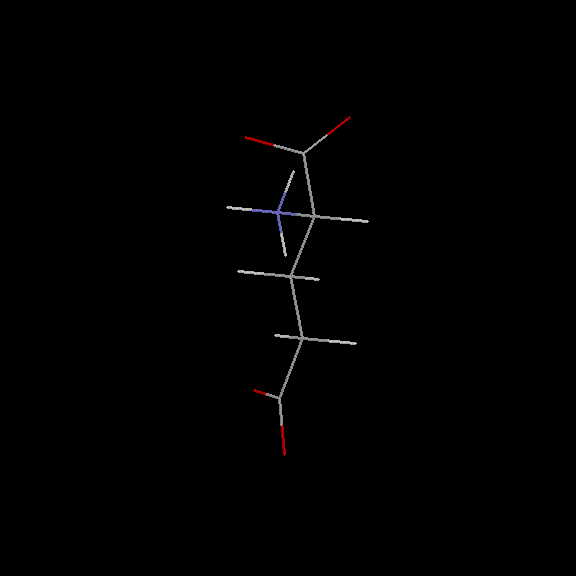L-glutamate
Glutamic acid, designated by the IUPAC-IUBMB abbreviations Glu and E, also known as glutamate in its anionic form, constitutes an α-amino acid. Its L enantiomer stands as one of the 22 proteinogenic amino acids, encoded by messenger RNA utilizing the GAA and GAG codons. Characterized by the presence of a carboxyl group –COOH at the end of its lateral chain, it is negatively charged within proteins. Its van der Waals radius measures 2.109 Å. While it is non-essential for human nutrition, in certain cases, the body may produce it in insufficient quantities, necessitating dietary intake.
Glutamic acid assumes a critical role in its cellular function, but it is not considered an essential nutrient in humans as the body can synthesize it from simpler compounds, such as through transamination of α-ketoglutarate, an intermediate product of simple sugar oxidation in the mitochondria (Krebs cycle).
As the ionized form of glutamic acid, glutamate represents the most crucial excitatory neurotransmitter in the central nervous system. Its action is counterbalanced by the inhibitory effects of GABA, of which it is the principal precursor.
Used as a flavor enhancer responsible for umami taste in its sodium salt form (monosodium glutamate or MSG), it is generally not considered toxic. This is primarily due to its inability to cross the blood-brain barrier because of its high hydrophilicity. Nonetheless, high and chronic concentrations of glutamate have been associated with documented toxicity, despite somewhat conflicting results. Chronic use is accused of inducing neurotoxic effects and excessive renal damage, although these aspects are not entirely elucidated.
When the balance is disrupted and glutamate concentration reaches excessive levels in the synaptic cleft, or remains there for an extended period, it can overstimulate neurons and lead to their demise.
Accession Number : KLM0000183 This work is released into the public domain; please see our release statement.

Synonyms :
- L-GLUTAMATE
- Glu
- E
Config Rule :
config('L-glutamate',[
substituent(aminoacid_L_backbone),
substituent(ethylcarboxyl),
linkage(from(aminoacid_L_backbone,car(1)),
to(ethylcarboxyl,car(1)),
down,single)]).
%%%% Substituent Config Rules for compound 'L-glutamate' %%%%
config(aminoacid_L_backbone,[
left(amino),
right(hyd),
top(carboxyl),
center(car(1))]).
config(ethylcarboxyl,[
top(car(1,hyd&&hyd;)),
center(methandiyl),
bottom(carboxyl)]).
Smiles String :
[C@2H]([NH3+])([C](=[O])[O-])[C@2H2][C@2H2][C](=[O])[O-] 'L-glutamate'
Fischer Diagram :

Terminal :
% 'L-glutamate'
c(1,12,(0,chiral))-[n(1,left)~,h(1,right)~,c(2,up)~,c(3,down)~],
c(2,12,(0,nonchiral))-[o(1,nil)?,o(2,nil)?,c(1,down)~],
c(3,12,(0,nonchiral))-[c(4,left)~,h(7,right)~,c(1,up)~,h(8,down)~],
c(4,12,(0,nonchiral))-[c(5,left)~,c(3,right)~,h(5,up)~,h(6,down)~],
c(5,12,(0,nonchiral))-[o(3,nil)?,c(4,right)~,o(4,nil)?],
h(1,1,(0,nonchiral))-[c(1,left)~],
h(2,1,(0,nonchiral))-[n(1,right)~],
h(3,1,(0,nonchiral))-[n(1,down)~],
h(4,1,(0,nonchiral))-[n(1,up)~],
h(5,1,(0,nonchiral))-[c(4,down)~],
h(6,1,(0,nonchiral))-[c(4,up)~],
h(7,1,(0,nonchiral))-[c(3,left)~],
h(8,1,(0,nonchiral))-[c(3,up)~],
n(1,14,(1,nonchiral))-[h(2,left)~,c(1,right)~,h(3,up)~,h(4,down)~],
o(1,16,(-5.0E-01,nonchiral))-[c(2,nil)?],
o(2,16,(-5.0E-01,nonchiral))-[c(2,nil)?],
o(3,16,(-5.0E-01,nonchiral))-[c(5,nil)?],
o(4,16,(-5.0E-01,nonchiral))-[c(5,nil)?]
The Terminals for all the Config Rules are in Prolog Definite Clause Grammar (DCG) form.They can be checked in the Manual here.
The compound's PDB file can be seen here.
